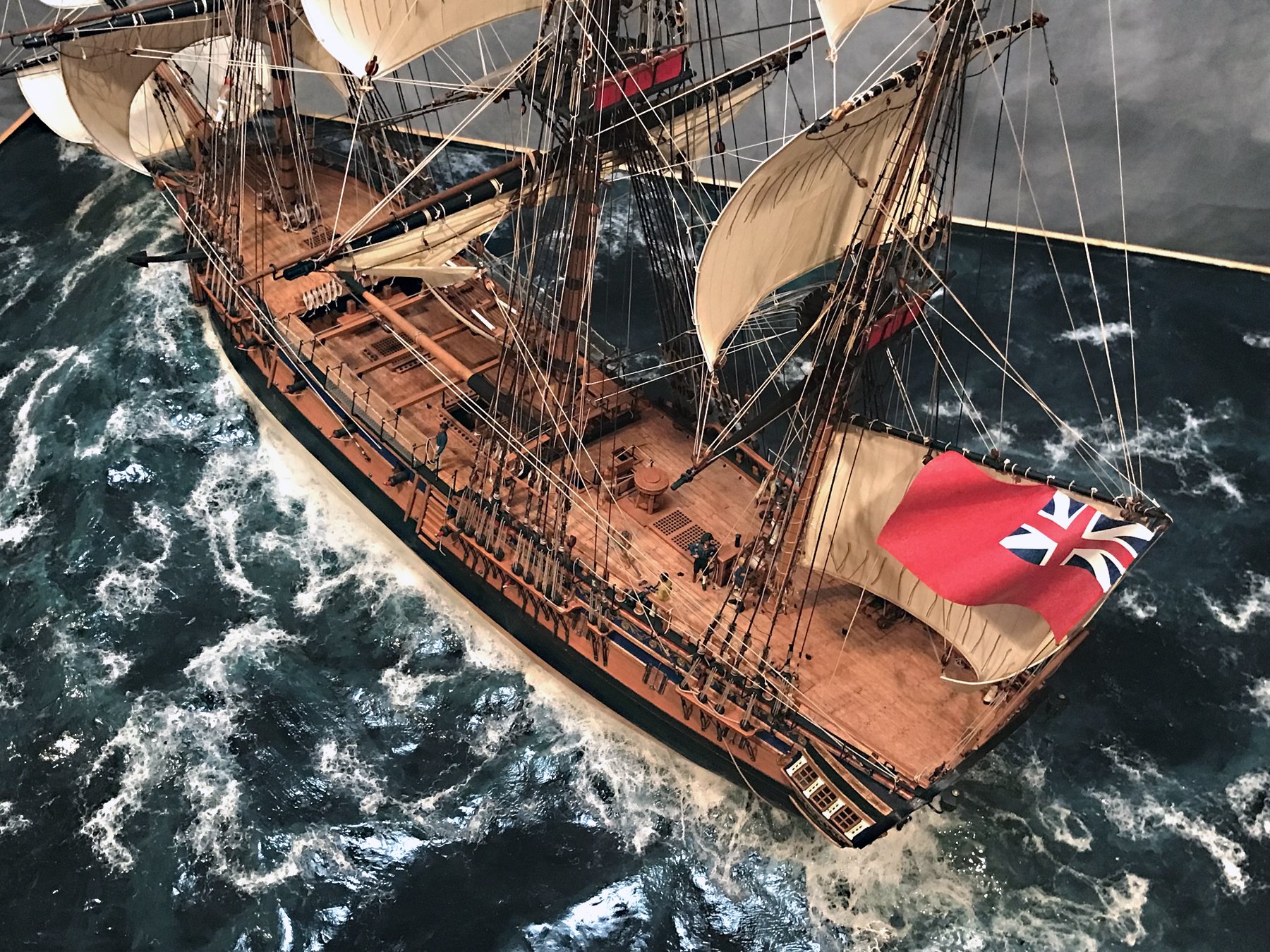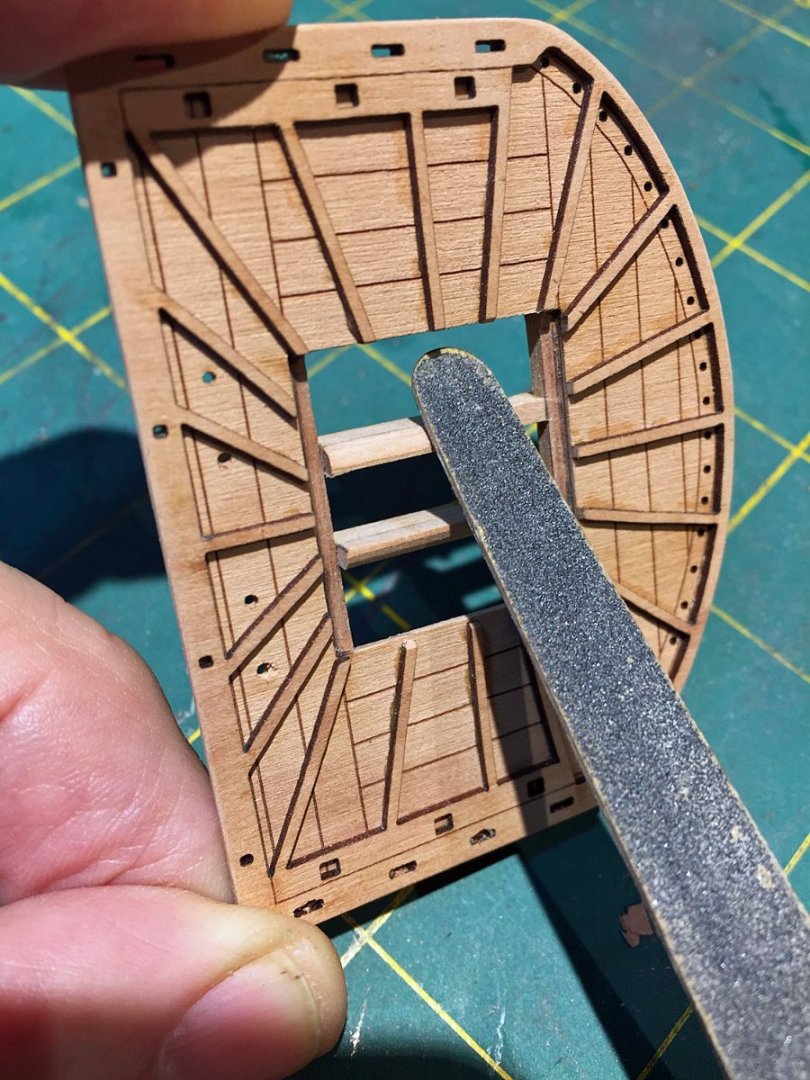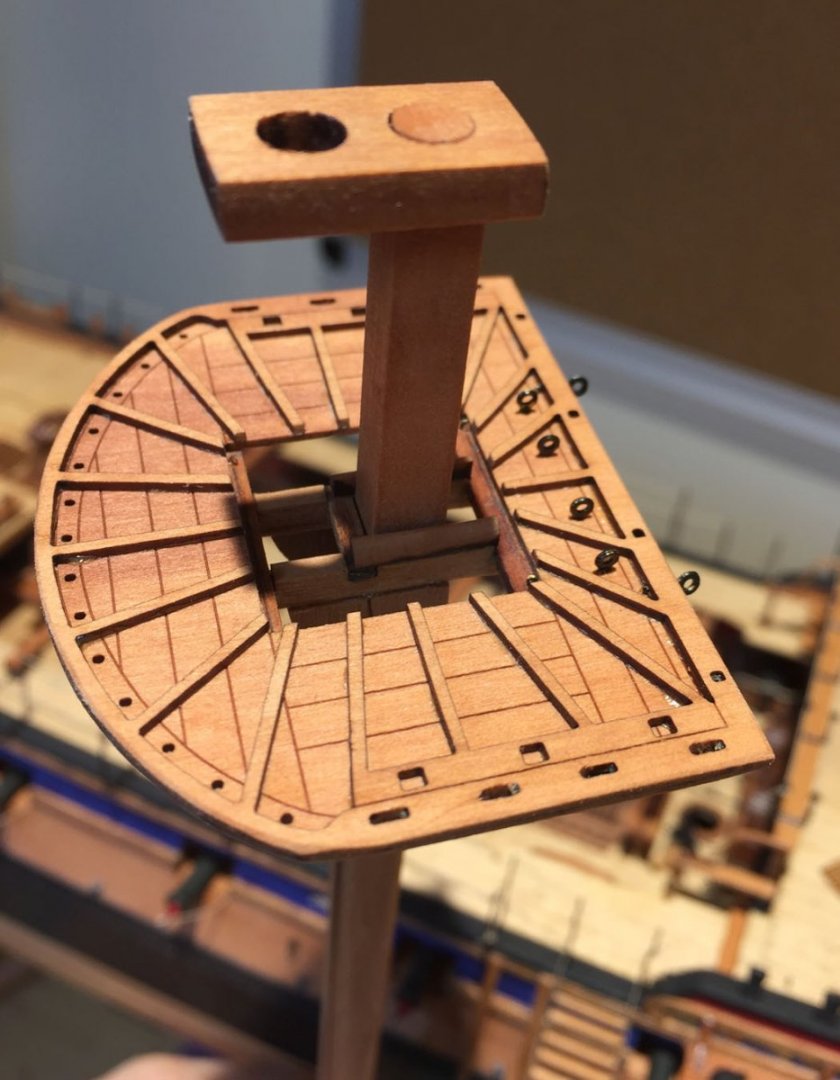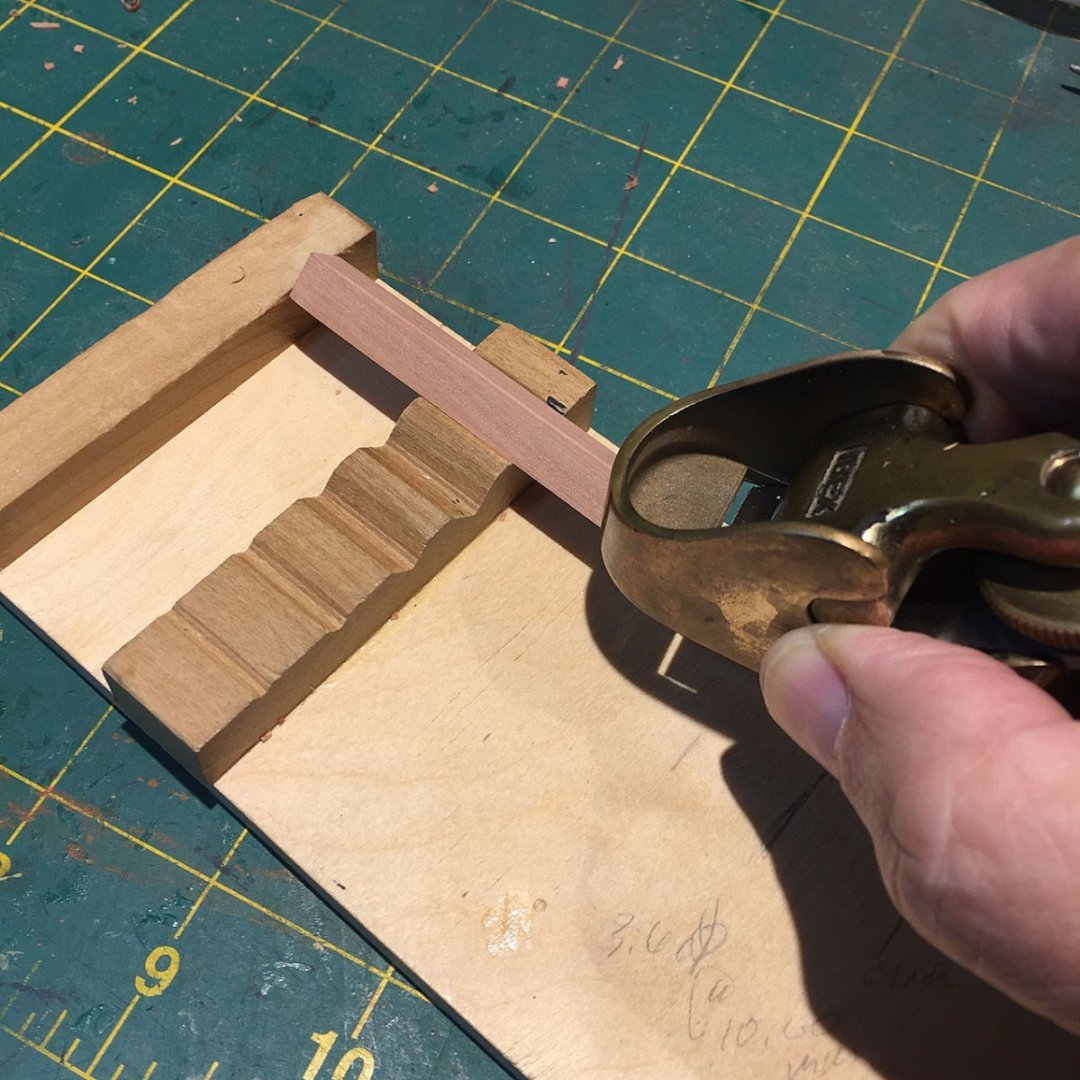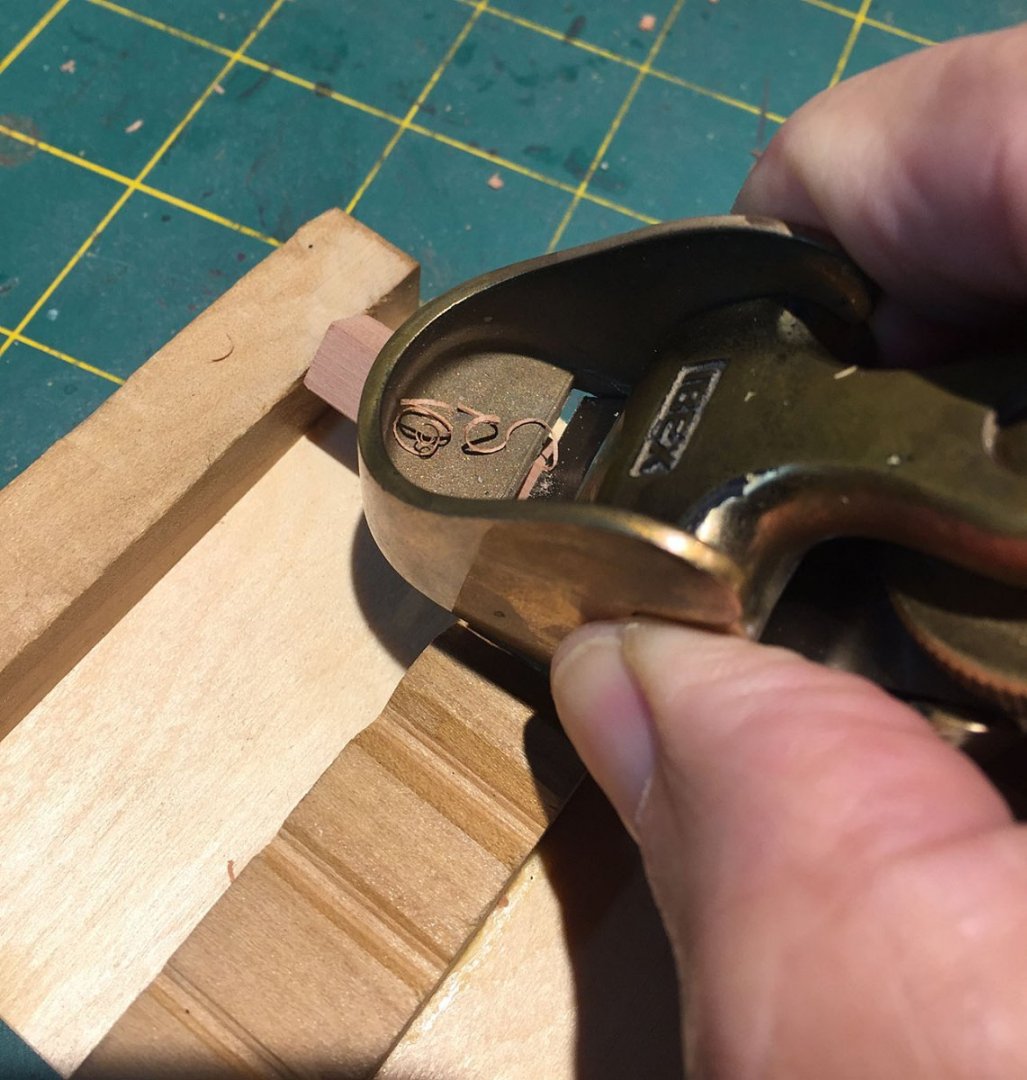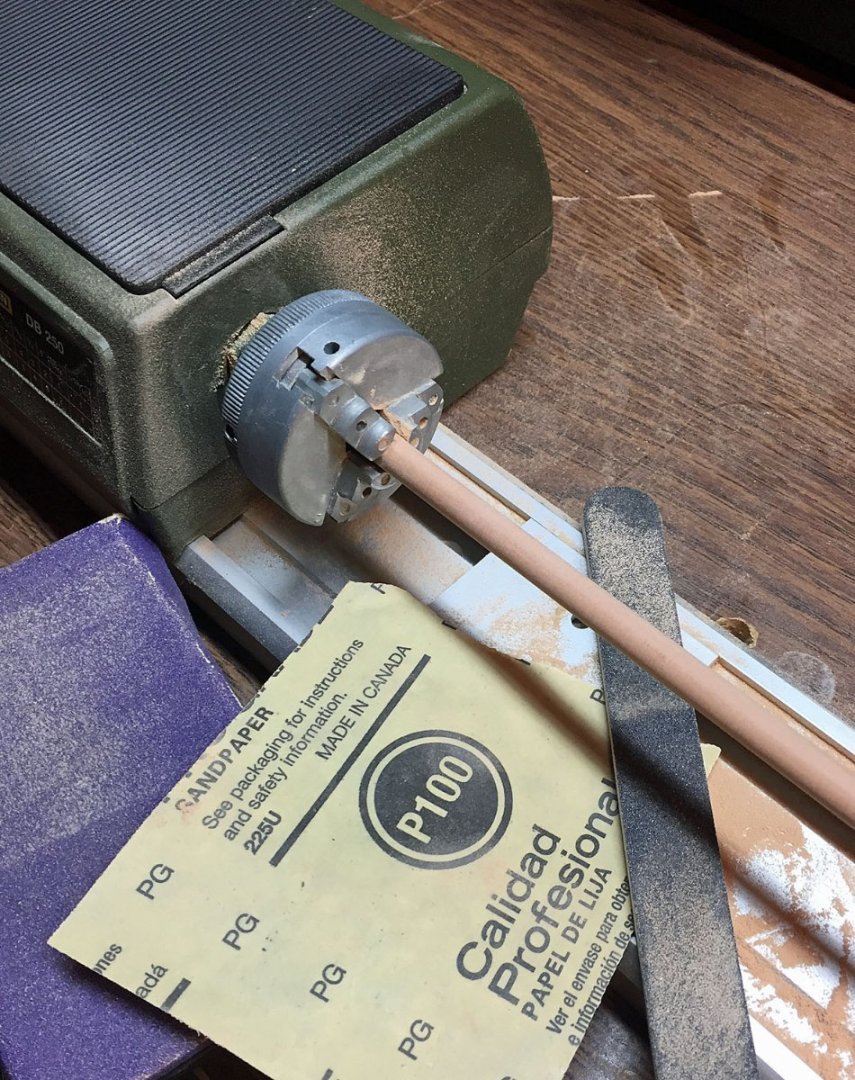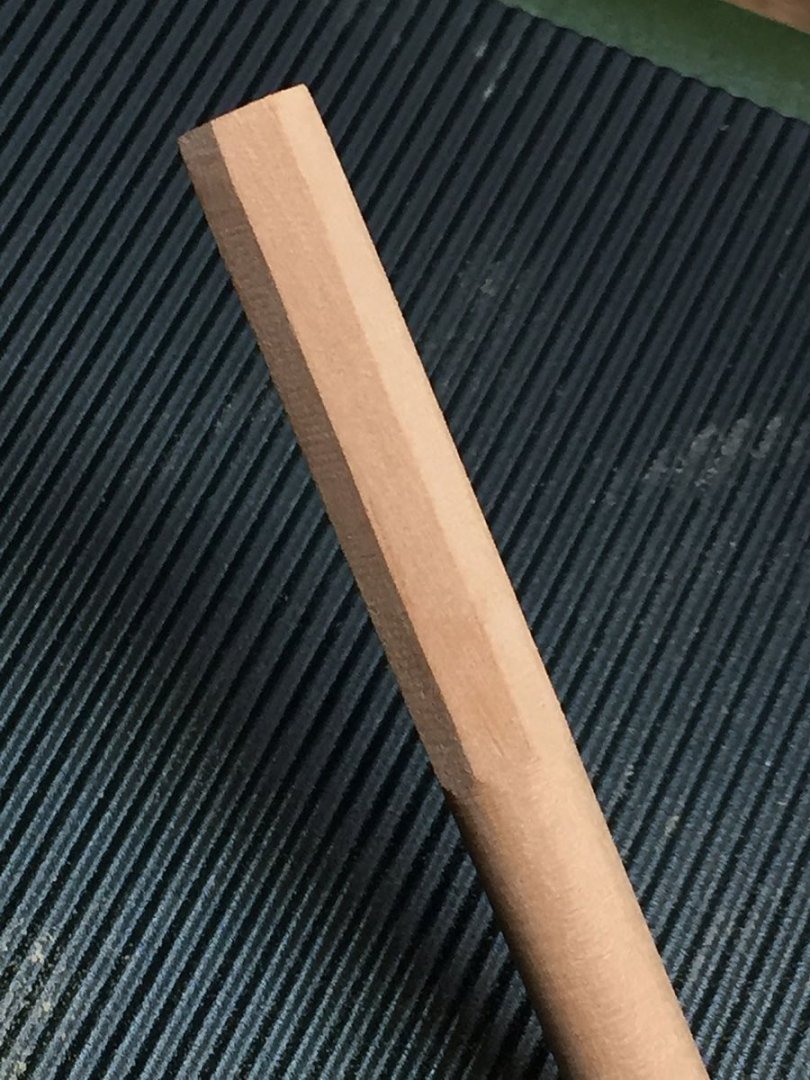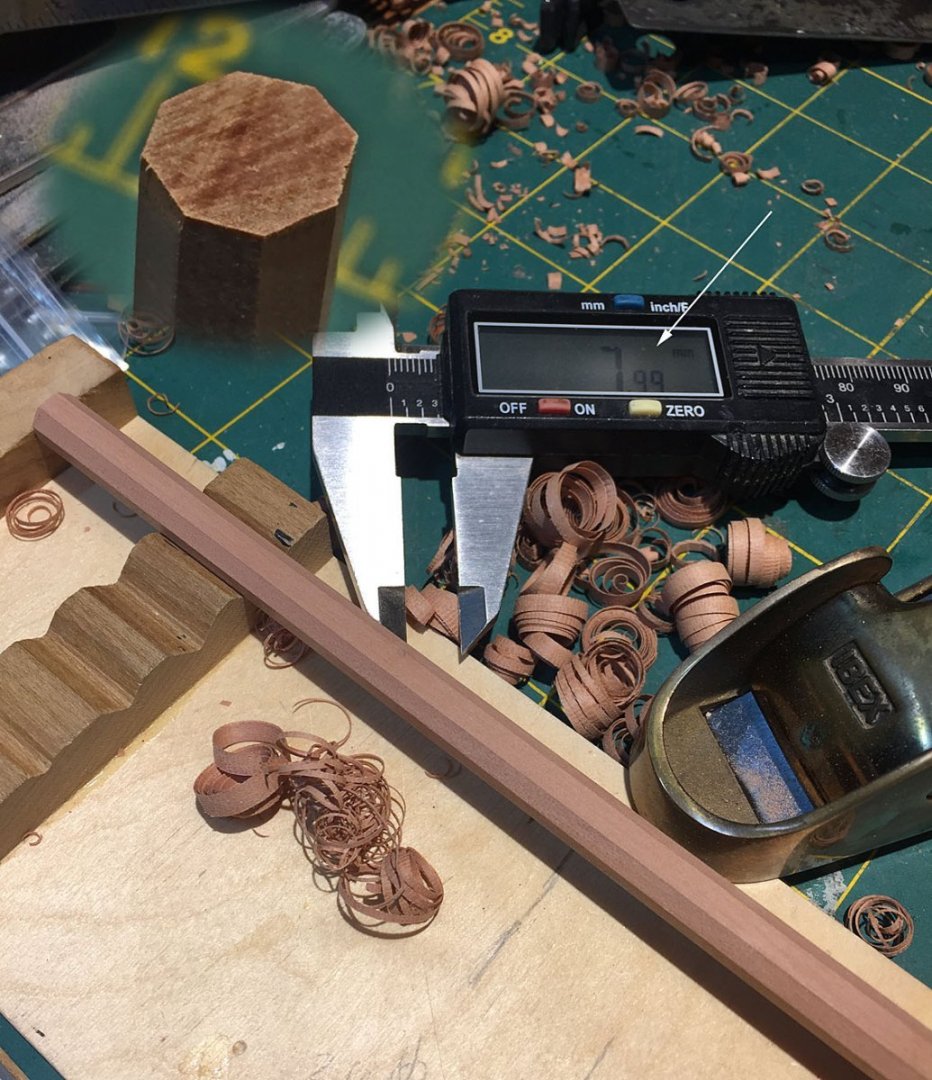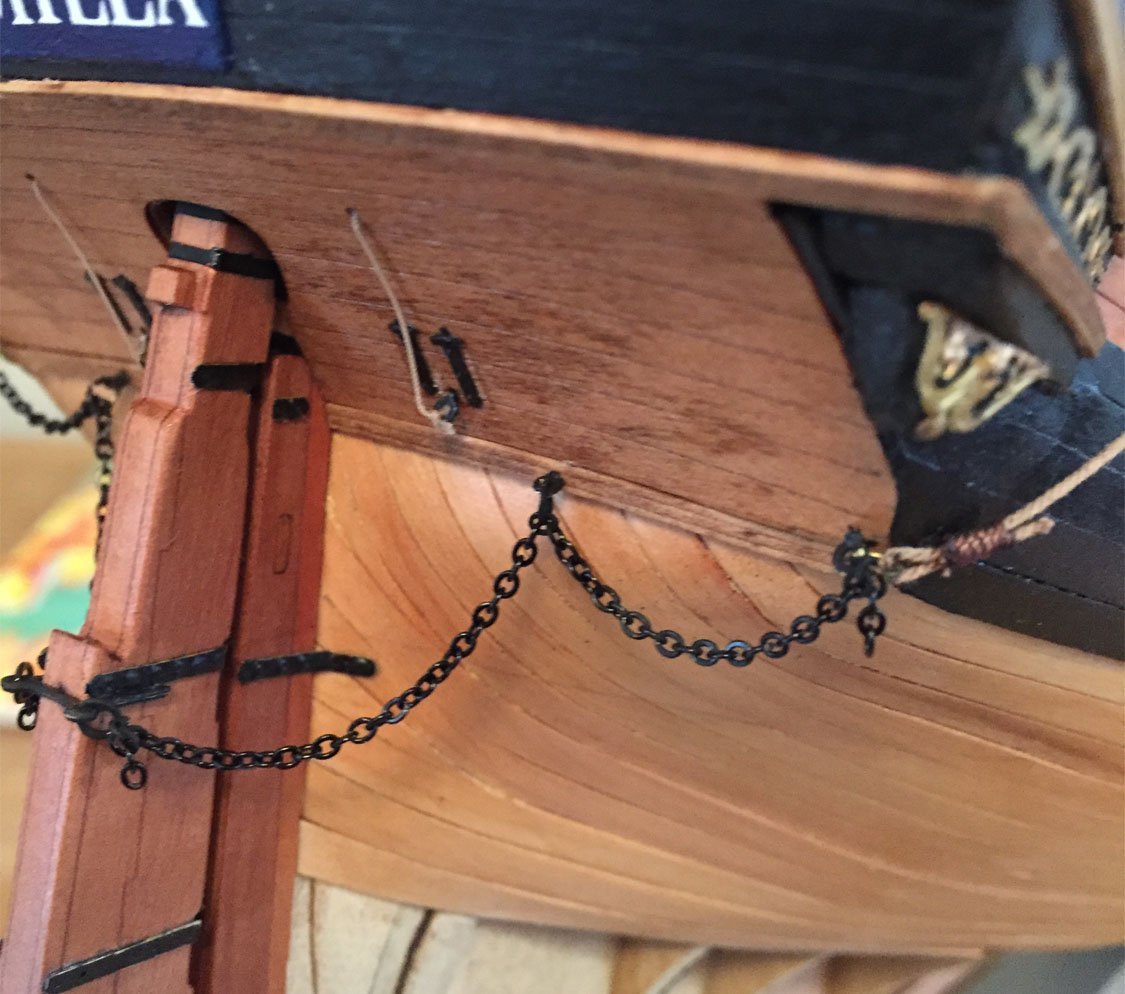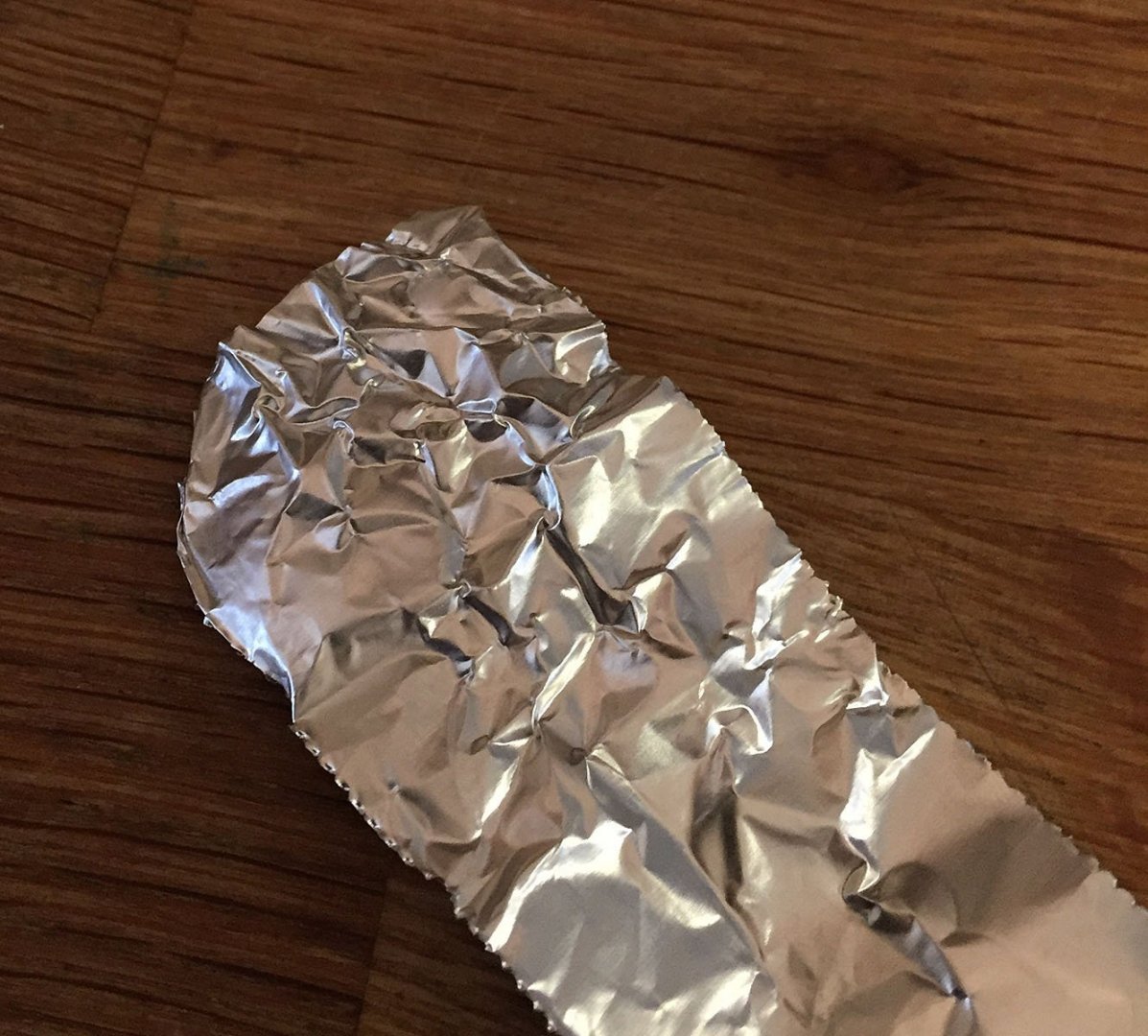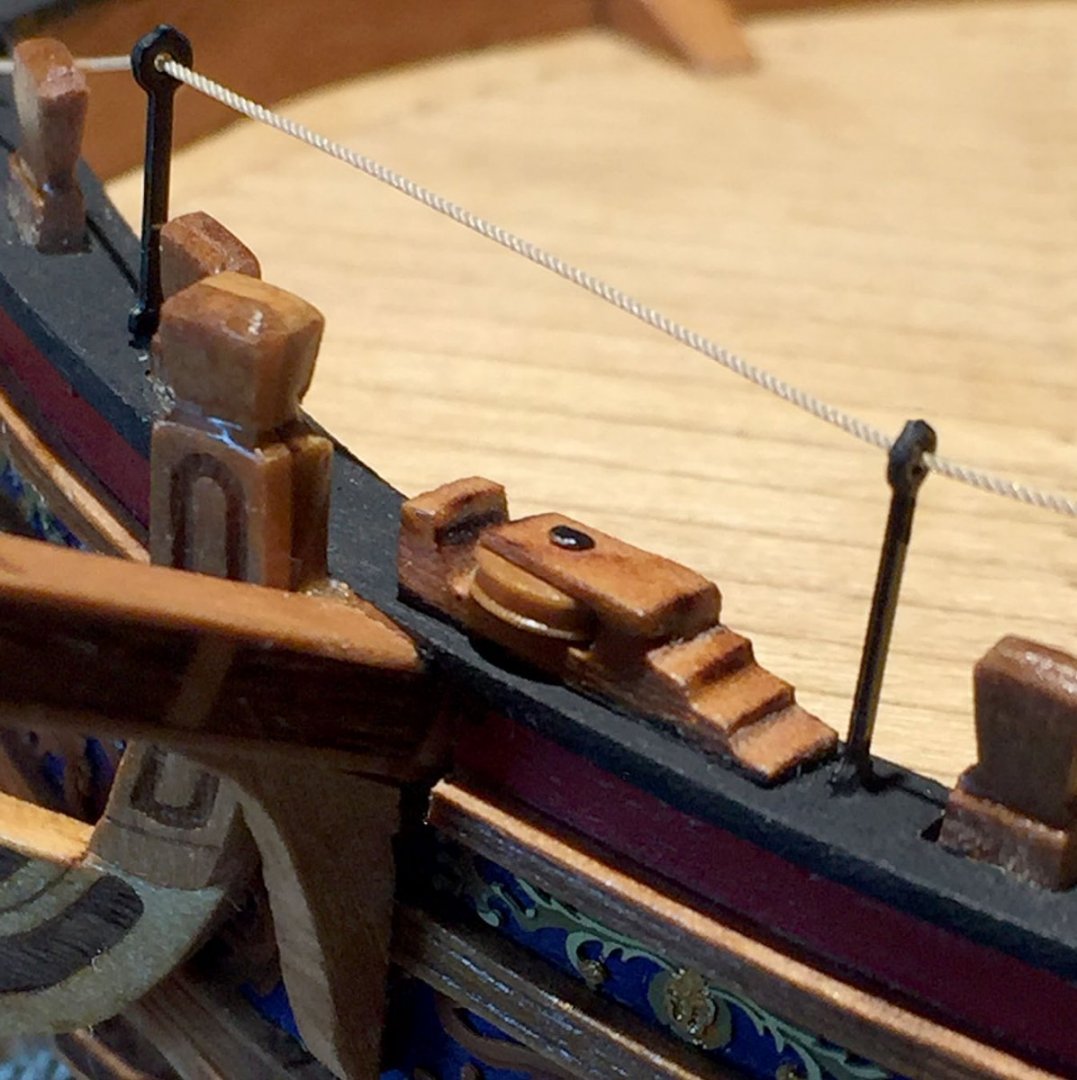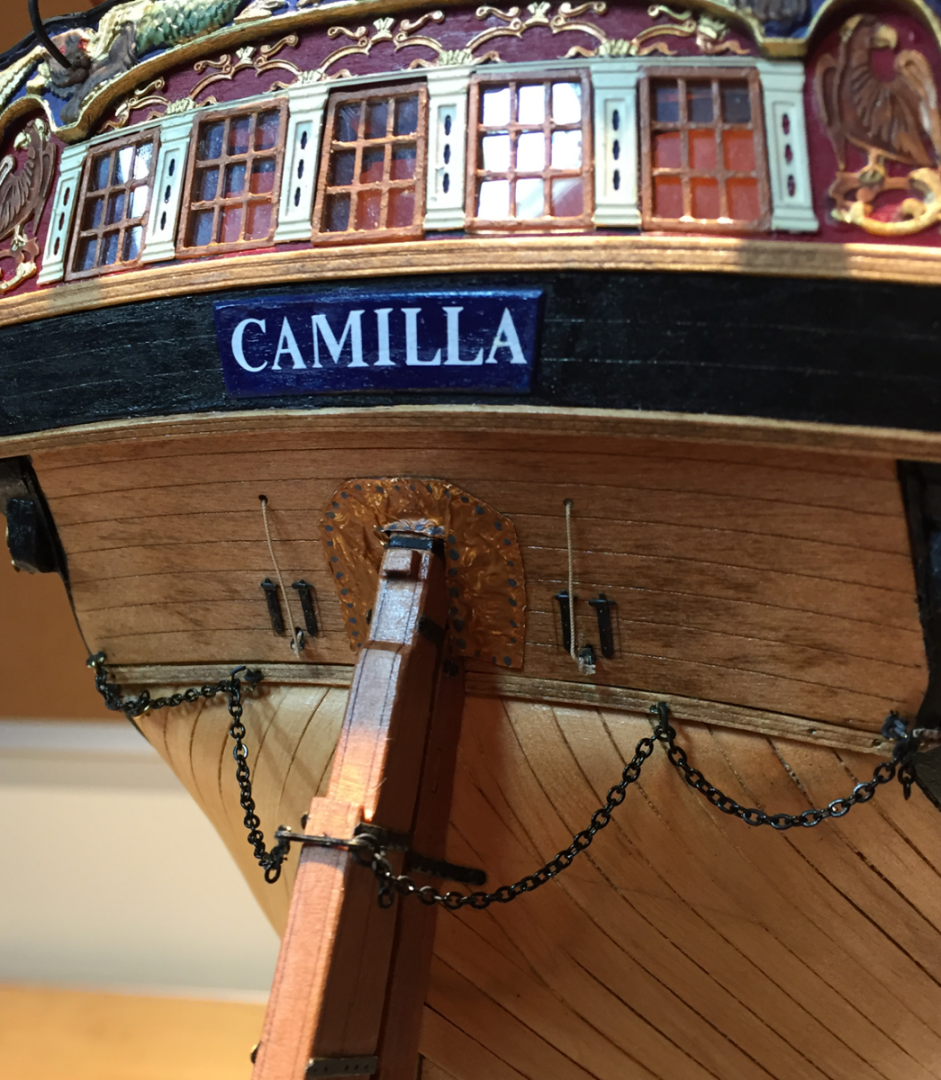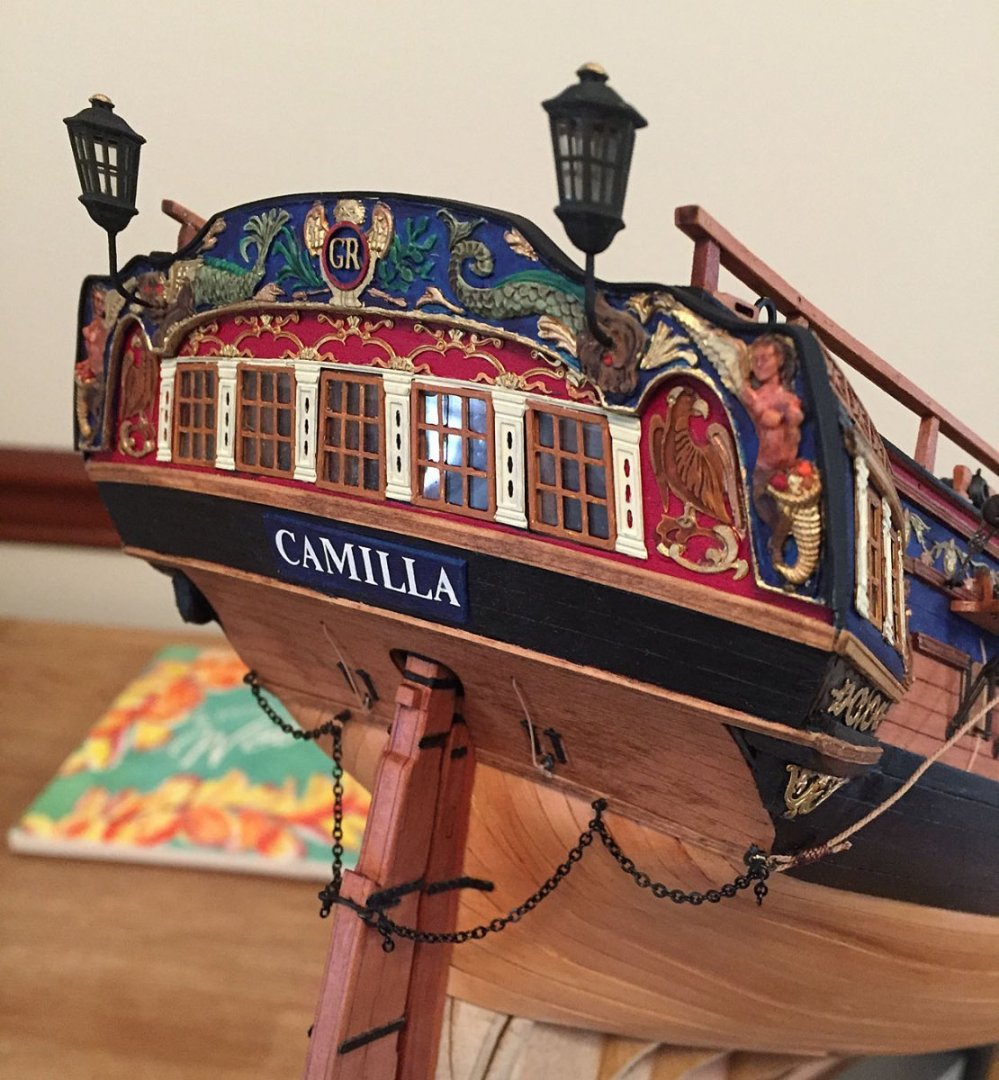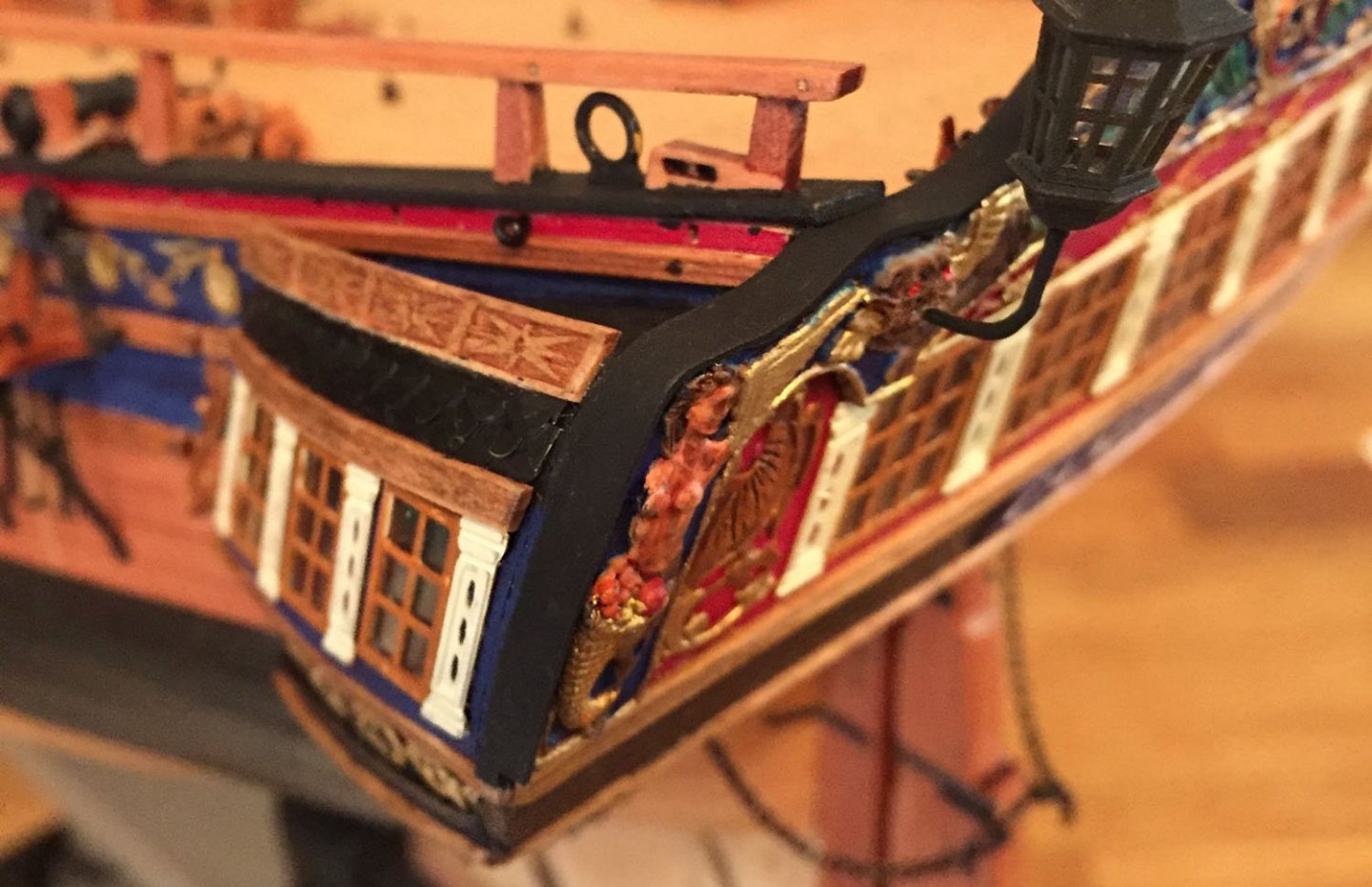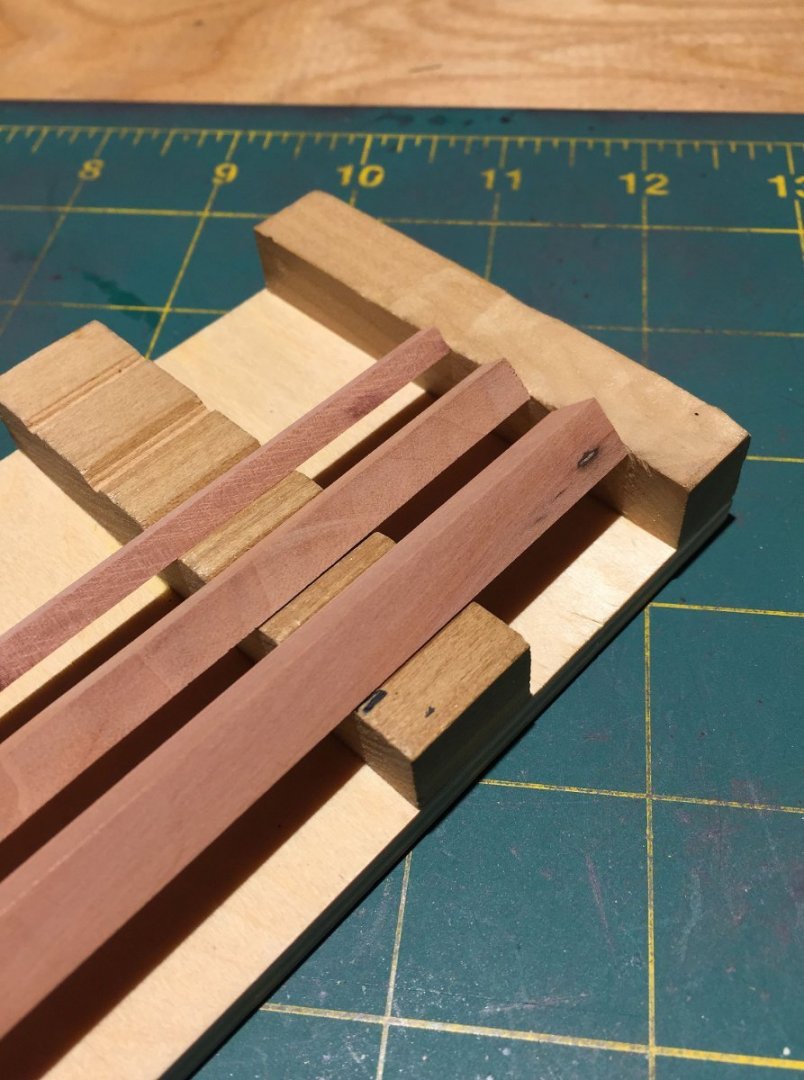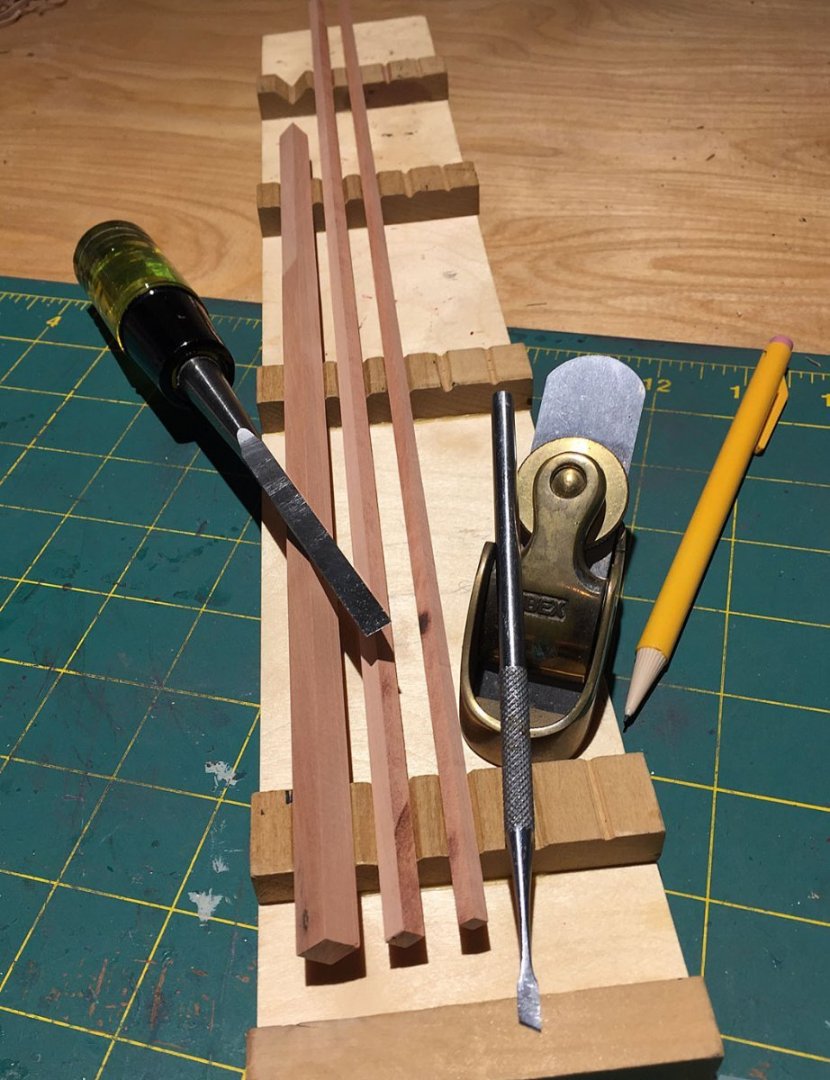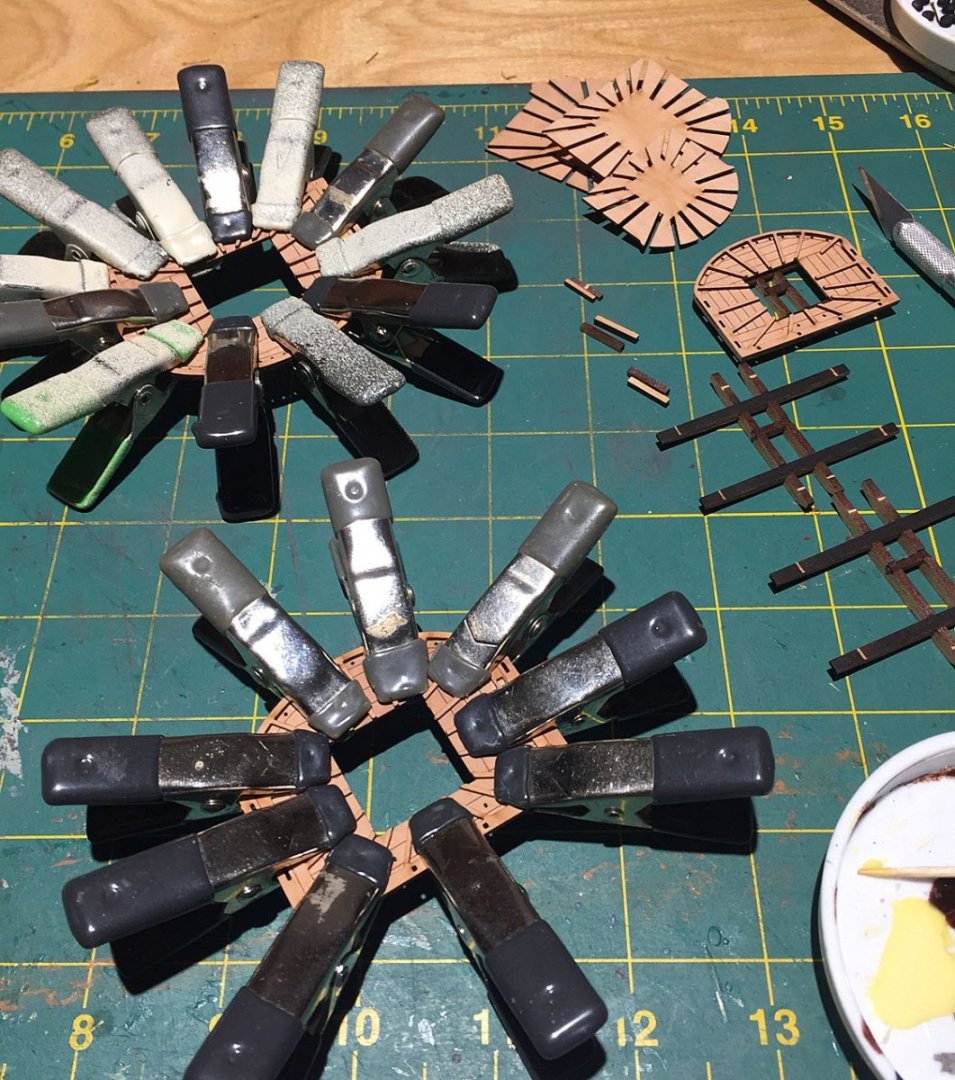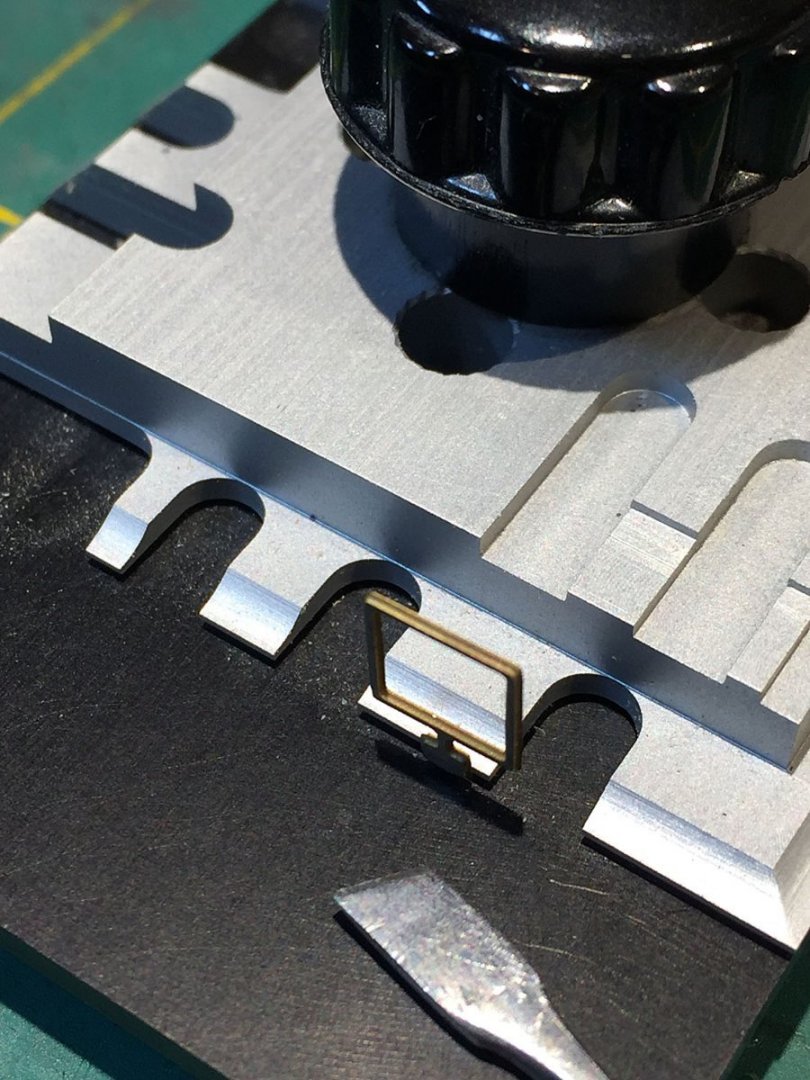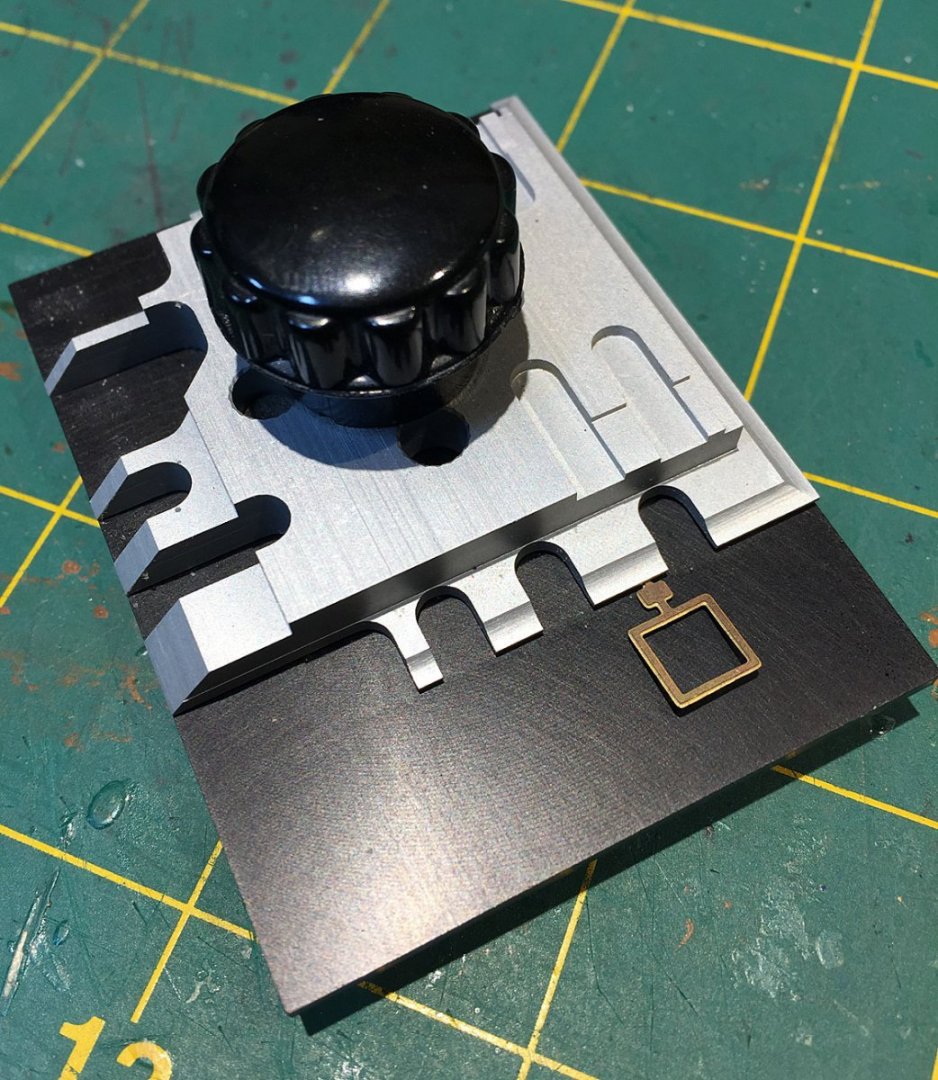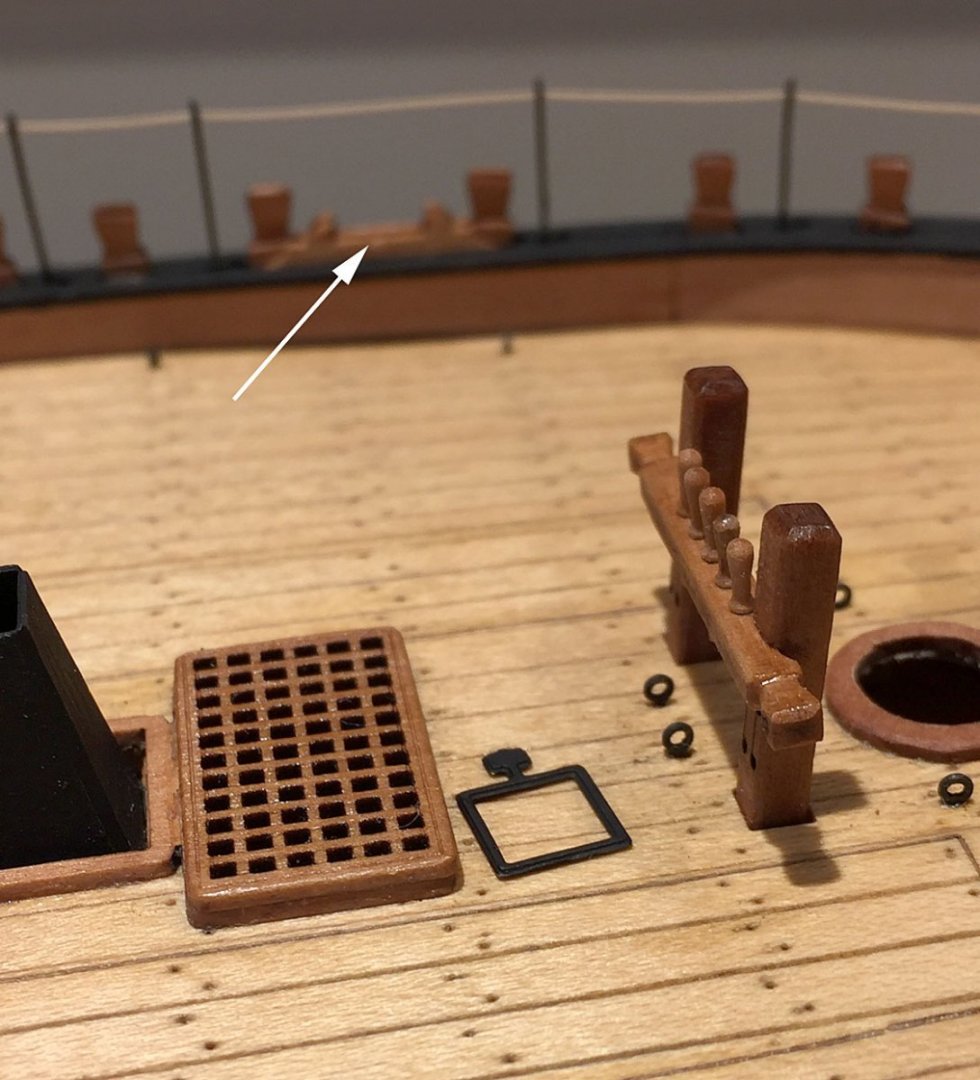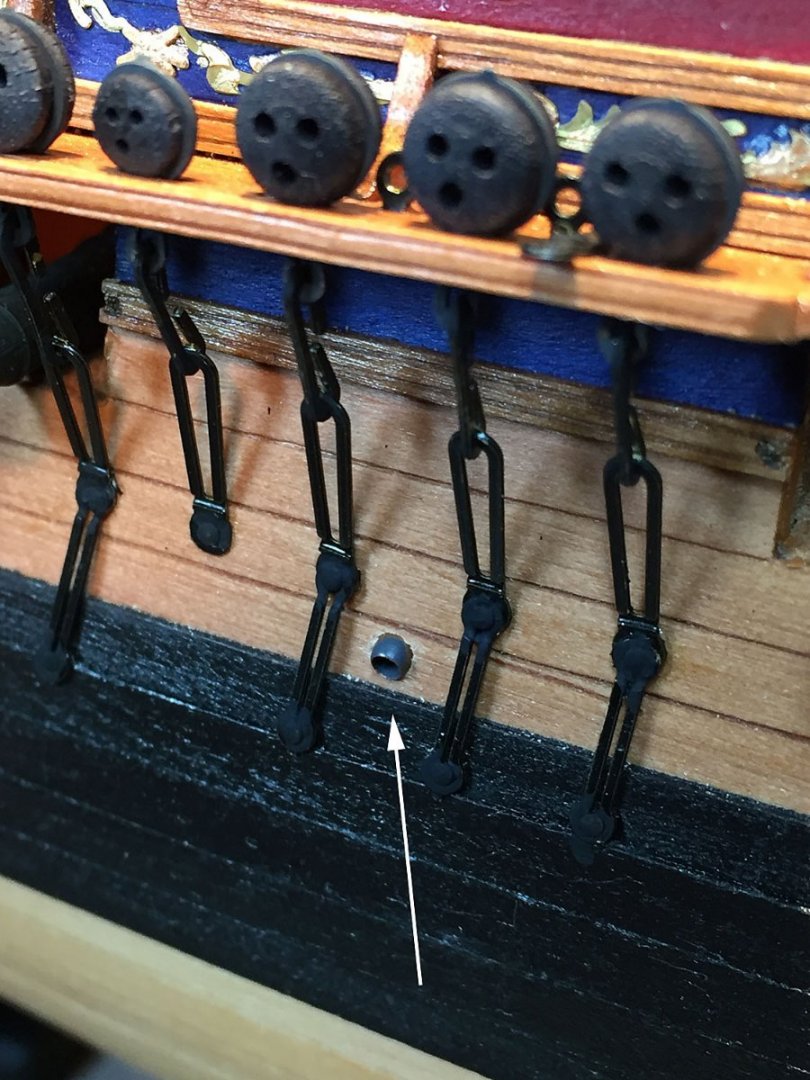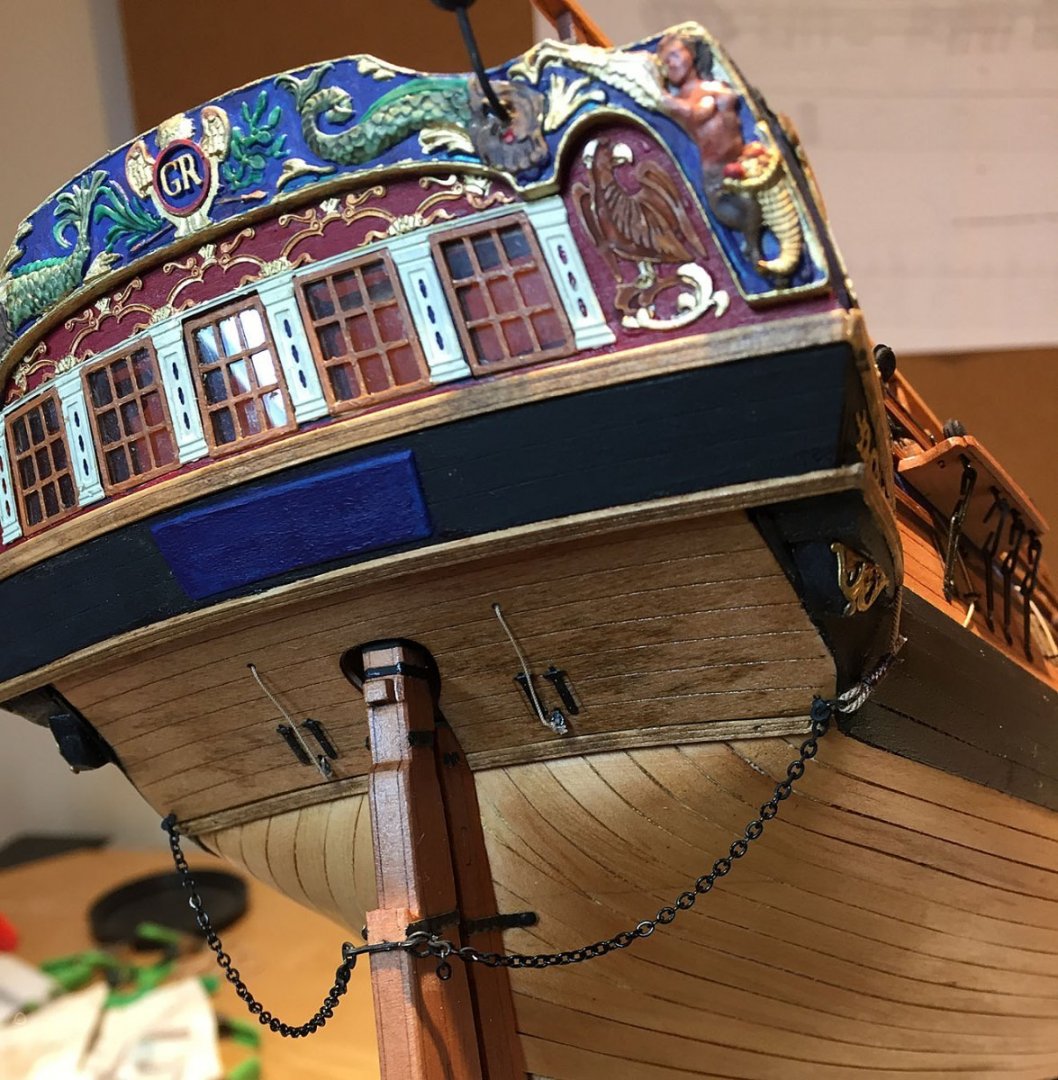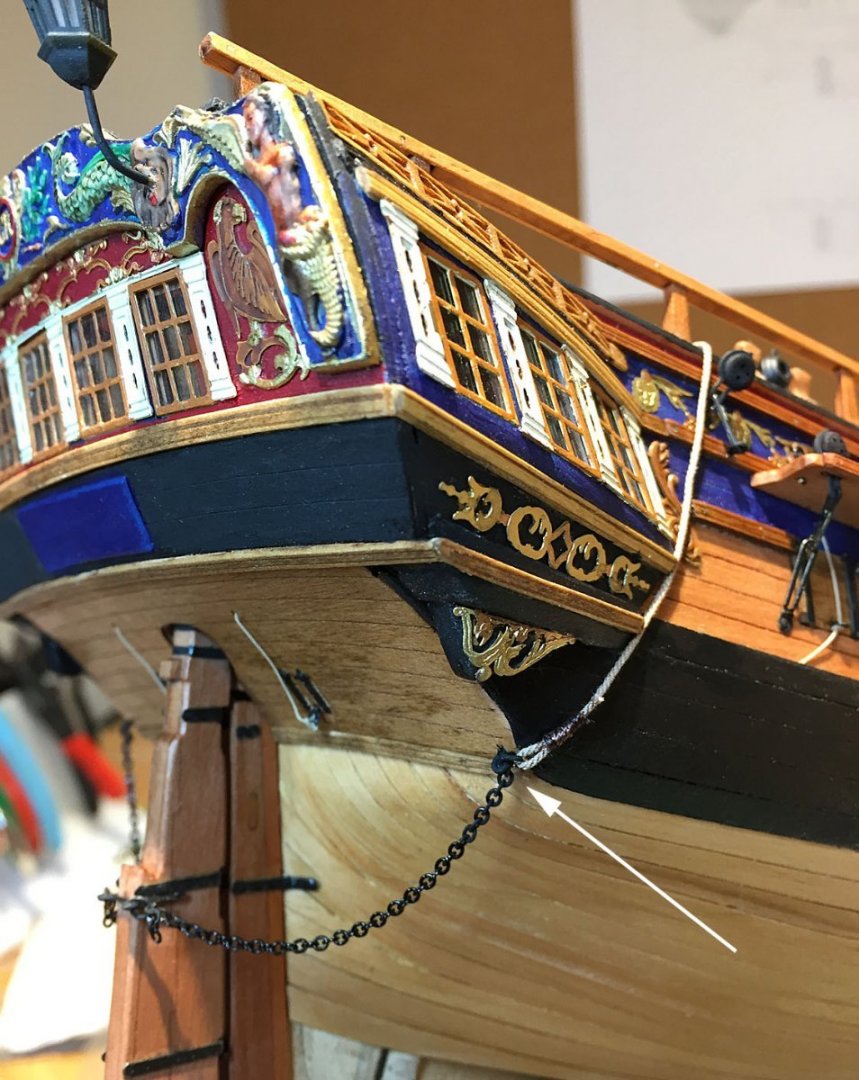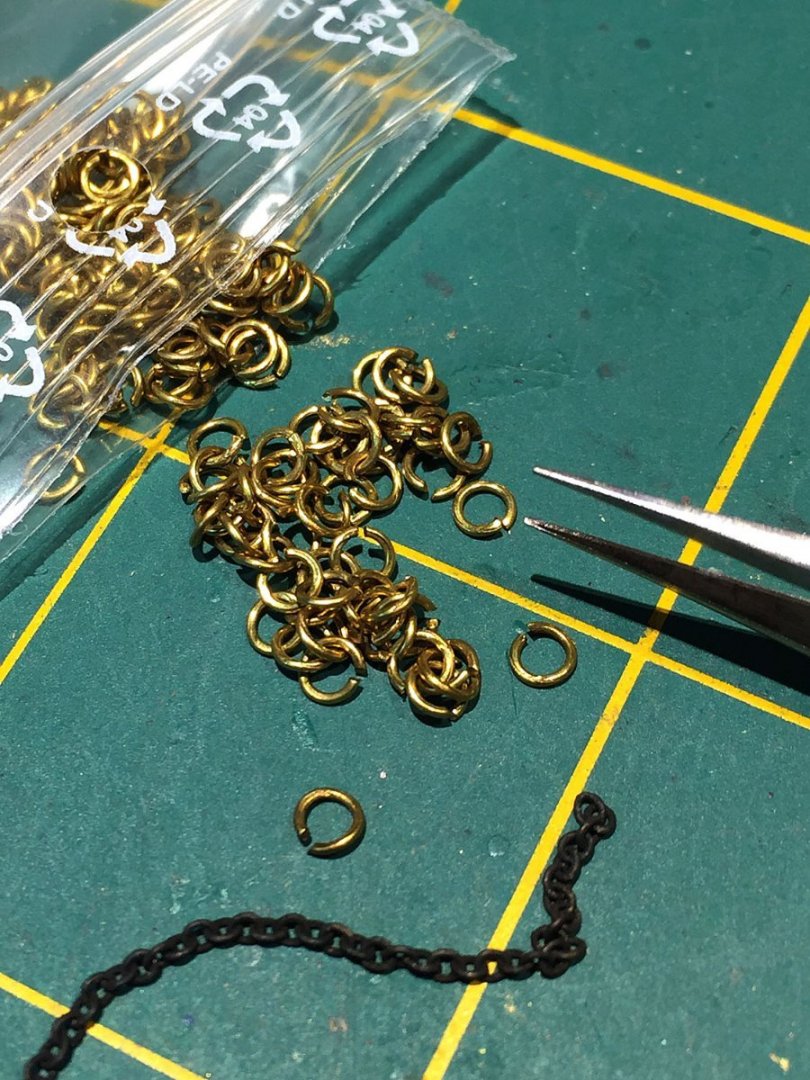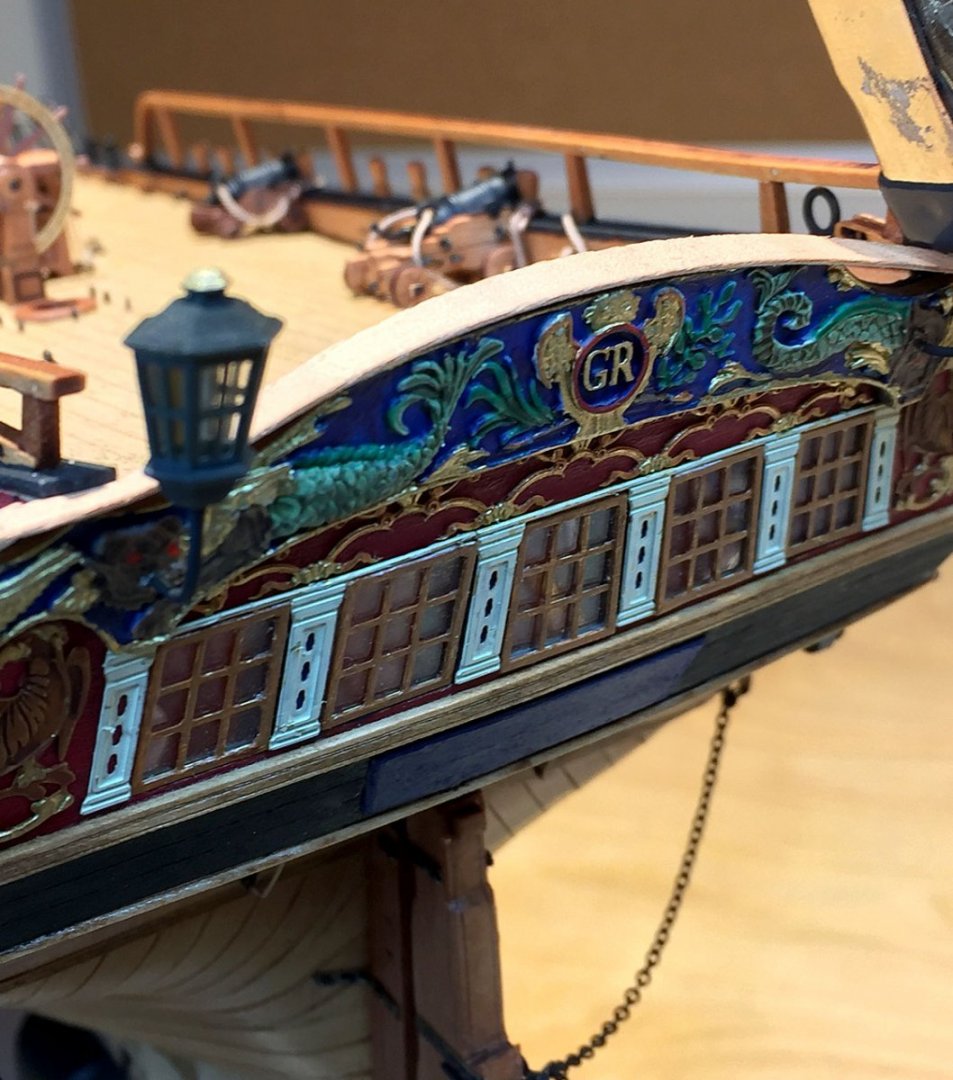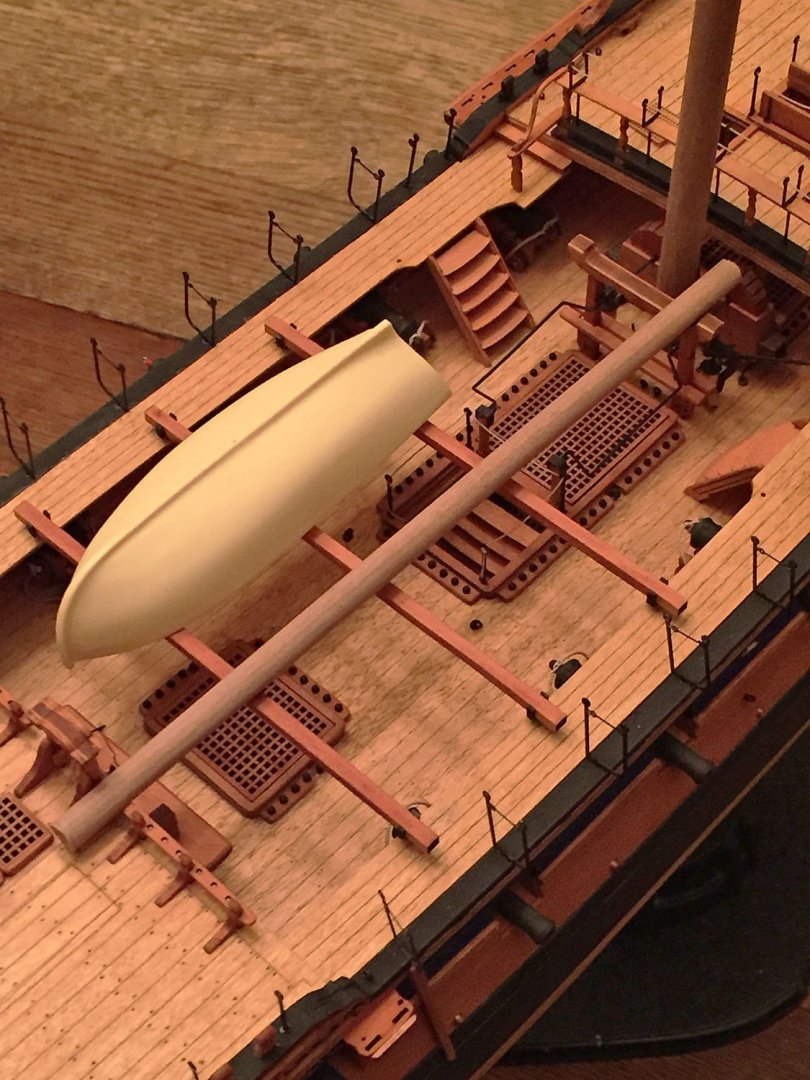-
Posts
1,554 -
Joined
-
Last visited
Content Type
Profiles
Forums
Gallery
Events
Everything posted by hollowneck
-
I Like it! Very nice work. Can't wait to see what you'll do with the Sphinx. ...don't forget to place a period after "Bob." - when you add his (?) name to the transom. Ron
- 840 replies
-
- winchelsea
- Syren Ship Model Company
-
(and 1 more)
Tagged with:
-
When I retired fifteen years ago, in 2006, I had lots of free time to read for leisure. I picked-up Patrick O'Brian's "Master & Commander" on a friend's recommendation because he knew I had lived in England. I got hooked, totally consumed for a couple months reading the entire Aubrey/Maturin series; absolutely brilliant writing, storytelling of epic proportions (and really stunning artwork on the book covers). Three years later, Peter Weir made one of THE classic films for us shipmodelheads! Master & Commander: The Far Side of The World. About ten years later in 2013, an embryonic ModelShipWorld was launched. I give my "high fives" to Mr. O'Brian, Mr. Weir and the many, many Tars - and Officers - of MSW for introducing and then guiding me in this fascinating, engaging and challenging world of model ship building. Ron
-
Indeed, SHARP is Good, Tom. I'll show a few photos of my sharpening guide, stone and the honing strop & compound I use to keep my favorite plane in tip-tip condition. The same sharpening and honing tools work for my conventional chisels too, but not my tiny (2-3mm) carving ones. Keeping razor sharp blades takes some attention and time but the tools I use to help achieve this are neither fancy nor expensive. Ron
- 542 replies
-
- Sphinx
- Vanguard Models
-
(and 3 more)
Tagged with:
-
Excellent work, B.E. Scratching the coamings and gratings was such a worthwhile effort for your model. Your extra, accomplished detailing is especially important for an Admiralty-styled build. Ron
- 855 replies
-
- Sphinx
- Vanguard Models
-
(and 1 more)
Tagged with:
-
Thanks B.E. & dodgeyhack (love your alias!)... your look-ins are much appreciated. The Ibex planes are essential tools in my bench arsenal. I'm quite lucky now that I have a separate work area where I can make clouds of sawdust (my lathe, a mini tablesaw, a disc sander, etc.). The double work rooms are a fortunate (and unplanned) result of a major house move this past summer where my wife and I agreed we needed to "downsize." 😳... I'm certainly not complaining...who gets to have TWO workshops a few feet from each other?!😁 Of course, my "sawdust room" has a portable room vacuum as well as a large air filtration unit. I'll take photos of my air cleaning solutions in a future post. They are not too expensive and work quite well for ship modeling's small stuff. I'm NOT making big furniture or cabinets - or turning Zebrawood fruit bowls. Ron
- 542 replies
-
- Sphinx
- Vanguard Models
-
(and 3 more)
Tagged with:
-
More scratch mast making details in this update...these photos focus on shaping the foremast. The processes here will apply across all three lower mast sections (the bowsprit will have some of these steps too). Shaping the crosstree bolsters on all three masts is an important step. These two, symmetrical rounded-off pieces are fitted to the tops and will support the shroud lines that wrap around the square mast post above the top landing. I have found it considerably easier to file these small square sections down AFTER they have been glued to the crosstrees below them. Take your time doing this to give both bolsters a smooth, evenly rounded profile. Also, insure the inside edges are perfectly flush with the crosstrees before gluing. There will be a little "tweak sanding" before the lower mast section can be "press-fit" inserted between the tree opening in a later step. I've used a thin, tapered nail sanding file (with a higher grit of 4 or 500) since the sanding angle is alternately steep and shallow. Larger files are difficult to properly form these bolster pieces and you don't want to remove too much material. Here the foremast top has been mounted to the built-up, completed lower mast. The mast cap has been fitted to the rounded section carved at the very top of the square section (that didn't get the octagonal planing and subsequent rounding-off). Note the position of the bolsters mentioned in the previous photo. I also recommend mounting all the eyebolts to the tops BEFORE mounting them to the lower mast assemblies. On the foremast there are ten (10) eyebolts for various blocks;. I'll rig the blocks after the top is firmly mounted. Pay attention to the profile angle of these tops; they should be parallel with the waterline since the masts have aft-leaning rakes. Don't forget to subtly "break" all the edges on the tops, above and below. Same goes for the square section edges up to the capping piece. An 8mm square pear wood "stick" has been cut to length and here you see how planing will shape the majority of its length into an octagonal shape. A closeup to show how the first passes of the finger plane removes very small, even curls of material. The plane is held level to the upward-facing square corner and when one pass is made the required length, the piece is rotated and each presenting corner is planed until all four have been reduced; this step is repeated until a perfect octagon is formed from the previous four sides. The plane's blade has been honed to razor sharpness, which is quite critical even with high-quality hardwoods like pear and boxwood. I've learned how to control the finger plane shown here (Ibex 7/8" wide blade), but some builders who use this mast making technique use a chisel, bevel side down. The plane works in a normal bevel up position and each successive pass removes more material until quite wide strips peel off the stock as long as the blade remains razor sharp. Here is the resultant octagonal section from the previous planing steps and how turning the octagon shape on a lathe will round it perfectly; this process works for the lower mast as well as for the topmasts (lower post section that inserts into the crosstrees and is supported by a "fid."). Note the transition from octagonal to round shape. The "lands" are even and when shaping the stock you'll need to double-check measurements quite often while planing to insure uniformity of all eight sides. I use a Proxxon bench top lathe (DB250) to turn the octagonal shaped pear into a perfectly round, smooth mast. I use a couple different grits of normal sandpaper to gradually work down the octagonal section. The sanding nail file is great to get into transition areas between square to octagon and/or round shapes. I run the lathe at its lowest speed setting. This particular lathe will chuck up to about 10mm of material and the length of material - from chuck to maximum extension on the moveable tailpiece - is more than adequate for all mast and yard turning, up to about 15". Here is a completed 8mm octagonally planed pear lower mast section; all eight sides are even the entire length. My calipers show the measurement of the planed lands to be 8mm across all sides. By making these lands consistent along the entire length, very little material will need to be removed when reducing the octagon shape to a round one. From this stage, the pear piece is put into my lathe for rounding-off. Note the various sizes of pear shavings, tiny-to-large "curls" of material. Next update I'll show closeups of the built-up lower mast showing the three fish pieces (fore & main masts) as well as the iron banding and wooldings. Also, I'll add the battens and align the capping to ready the lower mast assembly for the topmast which is considerably more involved to make correctly. Ron
- 542 replies
-
- Sphinx
- Vanguard Models
-
(and 3 more)
Tagged with:
-
Thanks for sharing these photos Eric. I really like your finishing choices. Nice job! Ron
- 12 replies
-
- Lowell Grand Banks Dory
- Model Shipways
-
(and 1 more)
Tagged with:
-
I just ordered a 22' boat from Vanguard for my HMS Camilla build. $36 USD inc. shipping (standard post from the U.K.) This will now replace the previous resin hull one from Caldercraft I was planning on using (I showed this one as a temporary placeholder on my HMS Sphinx Build Log). I won't be needing it for a few weeks, but I'll wager that Chris will get it shipped out before I hit the submit reply button here...😆 I anticipate this added clinker hull boat - once pimped-out so it looks like wood - will be the cherry on top once I'm done with rigging and sails. Ron
-
I agree that the Vanguard small boat option is a good one! I intend to order a 24-footer from Chris and tie it down on my Sphinx (HMS Camilla) model. After some painting and minor detailing, the clinker hulled launch ("turned turtle") will look really nice as well as more historically accurate. Personally, I have no particular desire to make one of the supplied boats in the kit although these lasered pear items look very nice. The construction pieces and manual all look good for those who want to follow the entire kit to it's finalé with all the boats presented (whether Admiralty-style, or masted & rigged). These additional little "mini builds" in the Sphinx kit will please many modelers I suspect. I've noted Chris' small figure on the deck here; I've been researching scaled figures for my model over the last few weeks. I'm hoping there may be a new source for 3D-printed ones that I can use since I'm placing my model in a fairly dramatic diorama setting. The NRG Store is now offering scaled 3D figures that I'm looking at seriously, but only a handful are in my build scale (1:64). I may resort to the same 'ole Italian castings I've used previously... Ron
-
Mark, Thank You. I appreciate your additional information. You've called it a "coat." Perhaps I can make a rudder coat out of black bear skin(fur)...that way nobody will be able to notice any details...and I will have "nailed it." Ron
- 542 replies
-
- Sphinx
- Vanguard Models
-
(and 3 more)
Tagged with:
-
Thanks for all the suggestions, gentlemen. I LOVE my Ibex too, Glenn.... ...and, you're correct...there's not enough "play" in my rudder boot. I need to revisit the bagginess (and B.E.'s remedies), and start over. No problem; I used acrylic adhesive (Liquitex Matte Medium) for attaching the foil piece to the transom. It will peel right off without damaging anything. Thanks to Jason too; there are a couple excellent logs to guide me on a better solution. On the snatch block B.E., I purchased these well-made pulleys from....wait for it, Falkonet (CraftySailor). I believe they are turned from pear stock, available in multiple sizes. Camilla's capping rail is now coated in satin poly and looks good, like it should! Happy New Year's - All...and thanks again for the tips. Ron
- 542 replies
-
- Sphinx
- Vanguard Models
-
(and 3 more)
Tagged with:
-
An Observation: Never attempt to "out pun" an Englishman. They invented the language. I never blame my dog since I don't have one now. But I do have a black hole in my shop floor.🤯 Ron
- 855 replies
-
- Sphinx
- Vanguard Models
-
(and 1 more)
Tagged with:
-
HMS Camilla gets her nameplate! Also, in this update, a few fixes and some additional stern detail before moving onto masting. Uploading weirdness continues; four files wouldn't upload. However, I found that re-saving images in .png format (rather than standard .jpg) allowed uploading the same photos. Oh well....curious glitch. I fixed the rudder chain mounting by adding an additional mounting iron (mid lower transom point, both sides). I looked this detail up in Lees Rigging "Bible" for confirmation. It definitely looks better and is historically accurate now. I added additional chain to get the extra length required for the rudder pendent usage. Thanks to B.E. here for the tip on where the rudder chains would be tied-off (in the mizzen channels). If the ship lost normal steering control for whatever reason, these rudder pendents would have tackle mounted to them and then be subsequently fed into an open port - and presumably, lashed to the internal steering system as an emergency, jury-rigged steering fix. A small piece of aluminum foil to be shaped and cut into a rudder boot. After mounting it gets some acrylic paint so that it appears to be leather. I went to our kitchen cabinet for this item...it's good to have a supportive Admiral. I forgot to show a photo in an earlier post that I added a genuine pulley to the snatchblock assemblies on the foc'sle. Anchor lines will feed through the pulleys. Genuine, three-strand rope looks good. It's .30mm dia. from Falkonet. I should mention here that I use rope from three different vendor sources: Ropes of Scale (new), Falkonet (CraftySailor) and SyrenShipModel : Thank You All. I would be highly bummed-out if I had to make rope for my ships. Ta-Da! HMS Camille gets her identity. I've carefully coated the lettering with satin polyurethane using a detailing swab to seal them. This photo clearly shows the "leather" rudder boot. The boot helped to keep water from rushing up into the rudder trunk. My intention is to show Camilla in choppy water with a following sea behind her stern, her cutwater crashing into the next large roller. Thanks again to B.E. who pointed out the necessity of this addition. The Captain's cabin would likely have been swamped without it! As far as I can figure-out and after researching this detail, I think the large leather boot was simply nailed to the transom and also onto the rudder at the same time. Anyone with additional details, pipe up! (please)... This view clearly shows the improved "Tafferal" atop the upper stern decorations, before I added the rudder boot. I'll also coat the flat black strip I used to improve this area of my build with satin poly. The .4mm thin pear wood strip didn't work well, despite soaking and heating. I went forward with a solution I've used in the past - and also suggested by B.E. - a thin section of white styrene. This did a decent job by conforming to all the topside undulations and continuing on over the rather sharp bends required to wrap all the way to the bottom of the galleries; all accomplished with a single piece of the substituted plastic (Evergreen Plastics) from port to starboard. Another view of the styrene capping I used to cover the not-so-nice looking stern layers. This "scratched" addition has dramatically improved the presentation of this part of the model. Other builders of this kit may want to seriously consider adding this easily scratched additional piece not included in the kit. Adding it in advance of how I've done it here will be much easier task to accomplish. My model will now appear more like most legacy models of the era. This added Tafferal will get a coat of satin poly after the black paint has dried. The Swiss pear square stock that I will use to create Camilla's three (technically, four) masts. Shown here are the three main sizes: 4, 6 & 8 mm. The pear stock rests in my planing jig. These 18" long pieces are dead-straight! The tools arrayed on the planing jig I use to shape the square stock for the masts. I use the small Ibex finger plane mainly, but on smaller square sections I use smaller chisels (bevel side down). I also use a sharpening stone before shaping work to keep the blades very sharp; minimal tool pressure is required to remove thin, even slices of wood. A square can become an octagon quite easily. An octagon can become a round easily as well... As I progress with the creation of my masts (including the bowsprit), I'll show how the various sections (round, square and octagonal) are fashioned. In reality, masts were very complicated carpentry wonders comprised of multiple sections with complex joinery. I've read that these specific dockyard workers were the highest paid. The kit's tops are being glued in this photo; I have purposefully indicated that you'll need several small clamps to get these properly glued together. After I rubbed white glue onto the top pattern piece with a fingertip, the piece wanted to curl and pop-up immediately from the base pattern. If clamps were not used there would be a lot of fiddly and messy aftermath of re-gluing of the thin support strips. These detailed pear pattern tops are laser-etched with loads of nice detail which you can't see here (later). When completed, these will be painted black but the laser etch detail lines will still show up, similar to the ship's wale patterns. The crosstrees for the tops have been assembled and the small square pieces alongside are the crosstree bolsters; once dry, I'll remove the "char" from all... 🤣 That's all for now, MSWer's. Ron
- 542 replies
-
- Sphinx
- Vanguard Models
-
(and 3 more)
Tagged with:
-
Thank You, B.E. I am aware the rudder chains (and ropes) could - in a pinch- steer the ship if the normal steering were out of commission. I wasn't aware that the pendant ropes were tied-off in the mizzen channels; makes good sense, tho! Thanks for this specific info. Presently, I've got these rudder pendants temporarily secured to a brace cleat on the q'deck which I did suspect wasn't the right spot. You've helped me suss out this detail. Correction forthcoming... Ah, yes, the curvy Tafferal. I also solved this identical issue with a thin strip of styrene for my HMS Swan build (neé Pegasus); the attached shows the capping piece in action, so-to-speak. If my thin pear won't do the trick, I'll use some styrene strip since that did work well. I encountered a similar problem years back that I partially resolved with some pear strip (HMS Ardent). Another Yes, I plan to add a small piece of shaped aluminum foil to fashion a rudder boot. I tried other materials but this worked the best in the past. I'll paint it to appear as flexible brown leather. I've envisioned the diorama placing Camilla in a nasty weather trough, between large waves, a large following wave at her stern! 😳 Ron
- 542 replies
-
- Sphinx
- Vanguard Models
-
(and 3 more)
Tagged with:
-
Found a little shop time post-holidays. This update shows a number of small fixes to various hull areas before the masts are created. I acquired a photoetch bending jig a couple years ago for precise folding/bending of small P/E parts. Shown here is a spanshackle after it's been bent to form its deck mounting pin. This piece will be mounted along the centerline of the foc'sle deck. A little earlier in my log the subject of fish davits and spanshackles came up. On a hunch, I trolled through several leftover stash boxes and found this small P/E piece from an earlier build; it's a scale-accurate spanshackle! After painting it black it gets mounted on the foc'sle deck, near the foremast. Lesson: save all your kit leftovers. I suspect most builders do. I store mine in various sizes of compartmented plastic pill boxes and divider boxes. Like various sizes of clamps, you can never have too many of these either... The flat P/E here is ready to be folded upward; a "lifting" tool- either a single-edged razor blade or the tip of a thin chisel - is used to form the various angles required on flat P/E pieces like this one. The multiple size"fingers" permit an unlimited variety of angles and clamping options; the aluminum clamping bar can be easily rotated to select various sized fingers to suit the P/E forming task. Here's the spanshackle, painted and mounted to the foc'sle deck. The square iron "shackle" could be raised (presumably a hinged asssembly) and one end of a fish davit would be held captive in this iron ring while the length of the davit rested on the "crutch" (indicated by the arrow). The davit beam was quite long and would thus extend well over the bulwarks to aid in hauling anchors. Davit crutches are mounted on the starboard as well as larboard gunwales. I decided to paint the scuppers a light grey color to simulate lead outlet pipes. Earlier in my build they appeared as copper piping. As I'm nearing completion of the hull I'm changing the color of some elements to be more historically accurate as well as more aesthetically pleasing. A NOTE: don't forget to close up the ends of the chain straps once you've mounted the deadeyes. I've mounted the rudder chains shown here but I'm doing some additional research now on the accurate depiction of these. Many legacy NMM models show rudder chains "draped" fully across the lower transom at two or more support points, rather than the single point of support shown here near the edge of the finishing piece. Rudder chains were critical. In heavy seas or with an unfortunate bottom scrape to the keel - or a good shot by an enemy- a rudder could suddenly become "unhinged" from its iron hull straps (pintles & gudgeons). I believe the stress that would be associated with a large, heavy rudder coming "unshipped" (the nautical term) would be tremendous and thus require multiple supports to keep it from breaking away completely from the stern - and thus floating away. Obviously, if this happened, a sailing ship was in rather deep doo-doo. The kit's supplied chain (besides being a little too shiny for my taste) isn't quite long enough to achieve the additional length along the transom, so I'll need to find a replacement that's long enough for both sides... hopefully there's some spare chain in my leftover stash boxes! YIKES! Reviewing my photos here, I just noticed on this particular photo (above) I omitted closing-up one of the mizzen chains, second one to starboard, beneath the channel. As I've commented previously, taking extreme closeup photos of one's model and looking at them critically will definitely reveal details that need more attention. The arrow points to the single point of attachment for the rudder chain, per the kit's plans. I will likely add two additional support eyebolts to show three points of support (per side), not just one and add the lengthened chains. There was heavy rope lashed to the chain to help retrieve an unshipped rudder from the ship's wake. "Jump rings" for attaching the rope to the rudder chain. These are handy little pieces I often use for other rigging tasks. There are none of these in the kit. I typically blacken them chemically (rather difficult to paint). These handy pieces can be found in the "beading craft" section of hobby/craft stores; I buy them (in different sizes) from Joanne's Fabrics. They can also be sourced from jewelry suppliers. Ugh! I am not happy with the funky, raw, unfinished look of this stern area. It doesn't look correct, appears incomplete and more important, doesn't represent a decent shipwright carpentry solution. Needless to say, it needs fixing. Unfortunately, I'll have to work around the stern lanterns to accomplish my fix and also be very careful to not break or scratch other adjacent details. Here's how I intend to deal with this "sore thumb." I have in my pear wood stash several strips of .5mm thick X 4.5mm strips. I need only a single short length to mount along the full width of this curved stern taffrail section (as the temporarily placed piece here shows). I plan to soak the pear wood strip in hot water for only a few seconds and then form it with my fingertips along the existing curved sections while gluing it in-place with some CA. There is no good way to mount this with aliphatic glue and clamp it, so the solution must be CA. Even Bondic won't work. The wetted, warm pear strip - in addition to being extremely pliable and flexible - will activate the CA. Once tightly pressed along the wood and resin edges beneath it, the pear strip will hold fast...at least that's my plan...stay tuned.🤔 Should this work out to my satisfaction, I'll paint this stern capping (taffrail) in black to match all the others. There will also be some inevitable touch-up to the decorative piece. Some may have spotted HMS Camilla's stern signboard badge has been colored in Pthalo blue, the hue I've used in my build. I've chosen this color to be consistent with the background color of the upper stern decorations. The lettering for her identity (in white) won't be added until the additional work at the stern has been completed, taffrail capping as well as rudder chain modifications. I've started gathering my pear wood square stock and planing fixture for mast making - which I hope to get started on in the next few days. I'll show this important fixture in a future post. Ron
- 542 replies
-
- Sphinx
- Vanguard Models
-
(and 3 more)
Tagged with:
-
I’m commencing from completion of second planking as much has been covered in other posts. This is my second model and I’ve tried to follow the build manual verbatim, nevertheless a few mistakes have been made. Glad for any feedback ----for some reason, the above text didn't import as a "quote" from the earlier, first post by Paul. NO biggie.... Welcome to MSW, Paul. From your photos it appears you've done a fine job thus far. Good planking. Congrats! On a scale of difficulty for high quality kits, I'd place the Vanguard Sphinx at about a 7 or 8 on a scale of 10; a definite challenge for a ship modeler's second build. Although it appears you are off to a good solid start, there are several good Build Logs here you that should help you with the balance of this challenging project. My other recommendation is to seriously study all of the many large plan sheets provided in the kit. If you've never rigged a large square sailer, you'll soon come to appreciate these drawings; they will be very helpful for this aspect of completing your model, particularly if you don't have detailed books on this topic. One more piece of advice: DO look ahead in the excellent Build Manual. This exercise follows very closely with spending time with the plan sheets as you continue your journey. Cheers, Ron (hollowneck)
-
Very nice work on the upgrading scratch work for your coamings and hatches, B.E. The "roundup" will be considerably more evident on the weather deck pieces, but adding this "reveal detail" in your build will certainly add to your next level execution of this kit. The black finish will look very nice with the contrasting red painted elements and offers a visual consistency that will be appreciated by many (MSWers)...impressive addition! Ron
- 855 replies
-
- Sphinx
- Vanguard Models
-
(and 1 more)
Tagged with:
-
I also prefer square stock for all my masting - preferably pear wood - but boxwood would also work; adding this cost to your top-level kits is not a deterrent IMHO: I spend the "extra" money in any event on additional stock to finish my models. As B.E. says, doing the various profile work necessary for accurate-looking masts and yards is best accomplished with square stock; however, I agree this may not be desirable for your target market. The exception, as noted, would be the smaller craft you're offering which don't have the complexity involved with modeling Royal Navy warships. Related to this question, I have noted in my Build Log for the HMS Sphinx that I'm including only one of the boats, not all three offered in the kit. Indeed, your pre-production and tweaked resin cutters look very nice. In compatible scale length, I'd have no problem including them with my models; properly detailed -thwarts, oars, etc.- and finished to resemble actual wooden craft. They'd work a treat in my world... Cheers, Ron PS Check this photo out; Chris should recognize it instantly: it's a 22' Caldercraft cast-resin cutter hull, a kit they've offered forever. I love these well-done little guys; carefully detail them and they're respectable additions to any larger model.
-
You're in the right spot (and the best) for the right reasons, Michael. You'll find lots of support and genuine appreciation here for your upcoming creative work. It will be interesting to see what you choose to build and I hope that you seriously consider creating a Build Log for that ship model. A Warm Welcome, Ron
-
Mark, I'd encourage you to add the channels (whether or not you decide to add deadeyes). To me, a stripped-down Admiralty-style presentation would look naked without both of these critical components. My Confederacy with stub masts looks great w/o! Happy Holidays and My Best Wishes to you for a good, solid recovery as we all roll into the New Year, Ron
- 505 replies
-
- vanguard models
- Sphinx
-
(and 1 more)
Tagged with:
-
Thanks, Mike. The same back at'cha - you & yours. And a Happ(ier) New Year! Ron
- 542 replies
-
- Sphinx
- Vanguard Models
-
(and 3 more)
Tagged with:
-
.jpg.d84ec4dad1d7791e855dca06210ab6f3.thumb.jpg.f45209242e851d4409eca1a09293165b.jpg)
One of the proposed alternatives to the Panama Canal
hollowneck replied to bruce d's topic in Nautical/Naval History
Bruce d, I'm already there.... Doomed ships, or not, your thread immediately got me thinking that I'd like to build a 5-masted schooner being hauled across Panama on railway tracks. What a diorama this would make, an intriguing combination of a model railroad with a ship model. Probably not HO scale though....the medical tents and staff to deal with the results of mosquitoes would be a vexing challenge. I know! to bring the diorama into the 21st century, what about a 600ft. long Maersk container ship being dragged across Nicaragua by Teslas? Ron -
Thanks Derek. I've just had another closer look at some of your models and you are a fine modeler. The Sphinx will be a very rewarding experience and a good match with your previous projects. As you've likely already noted, my Build Log won't be helpful until you get to the later stages as I didn't start until most of the kit's skeleton/structural bits were completed. I do suggest looking-in at Build Logs for others who've posted in the early stages. There are a couple "gotchas" that are discussed and well documented ( I'm thinking virtually ALL the other builds ), mostly around the fitting and position of the stern patterns; this is a critical part of this build and others have explained their tribulations and subsequent solutions. As I've noted a few times in my Log, once you crack open the box of goodies and start fitting you'll soon discover the very close tolerances of all the pear wood pattern pieces, the beefy MDF parts. Like other recent Vanguard kits, the extensive P/E and the superbly-cast resin/3D printed components are a delightful step up. Good Luck on your journey. This kit rewards its builders with a "next-level model" of striking beauty and complexity in its presentation. Friends and family will exclaim: "OMG! Did you build that!" I suggest a confident, warm smile as your response. Cheers, Ron
- 542 replies
-
- Sphinx
- Vanguard Models
-
(and 3 more)
Tagged with:
About us
Modelshipworld - Advancing Ship Modeling through Research
SSL Secured
Your security is important for us so this Website is SSL-Secured
NRG Mailing Address
Nautical Research Guild
237 South Lincoln Street
Westmont IL, 60559-1917
Model Ship World ® and the MSW logo are Registered Trademarks, and belong to the Nautical Research Guild (United States Patent and Trademark Office: No. 6,929,264 & No. 6,929,274, registered Dec. 20, 2022)
Helpful Links
About the NRG
If you enjoy building ship models that are historically accurate as well as beautiful, then The Nautical Research Guild (NRG) is just right for you.
The Guild is a non-profit educational organization whose mission is to “Advance Ship Modeling Through Research”. We provide support to our members in their efforts to raise the quality of their model ships.
The Nautical Research Guild has published our world-renowned quarterly magazine, The Nautical Research Journal, since 1955. The pages of the Journal are full of articles by accomplished ship modelers who show you how they create those exquisite details on their models, and by maritime historians who show you the correct details to build. The Journal is available in both print and digital editions. Go to the NRG web site (www.thenrg.org) to download a complimentary digital copy of the Journal. The NRG also publishes plan sets, books and compilations of back issues of the Journal and the former Ships in Scale and Model Ship Builder magazines.

